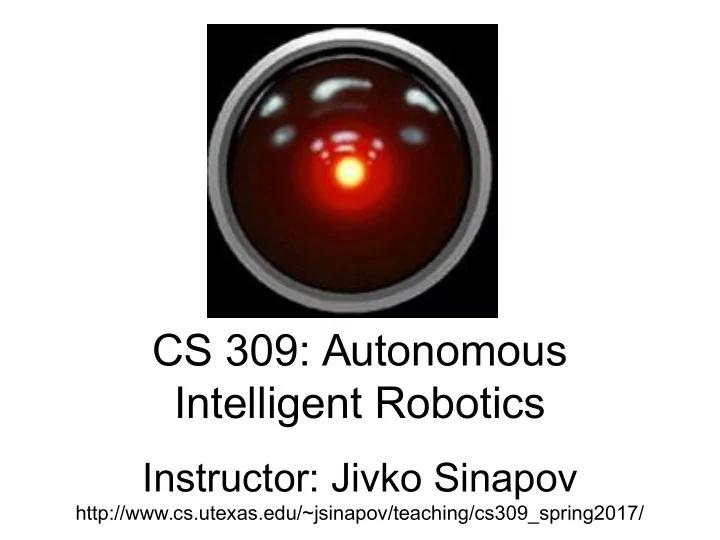

CS 309: Autonomous Intelligent Robotics Instructor: Jivko Sinapov http://www.cs.utexas.edu/~jsinapov/teaching/cs309_spring2017/
Announcements FRI Summer Research Fellowships: https://cns.utexas.edu/fri/students/summer-research Applications are due March 1 st but apply now! Funding is available for 4-5 students per FRI stream
Nick, Rishi and I attended AAAI http://www.aaai.org/Conferences/AAAI/aaai17.php
Robots that read your mind...
Announcements Homework 2 is due on Monday
Semester Schedule C++ and Robot Operating System (ROS) Learning to use our robots Computational Perception Developmental Robotics You are here Human-Robot Interaction Time
Progression 2D simulation 2D simulation 3D simulation Real World
The Gazebo 3D simulator • Install gazebo_ros package: sudo apt-get install ros-indigo-gazebo-ros • Run the simulator: roslaunch gazebo_ros willowgarage_world.launch
Today 1) Reading Discussion 2) Homework 2 Q&A
Reading Discussion Stoytchev, Alexander. "Some basic principles of developmental robotics." Autonomous Mental Development, IEEE Transactions on 1.2 (2009): 122-130. Minsky, Marvin. "Steps toward artificial intelligence." Proceedings of the IRE 49.1 (1961): 8-30. Veloso, Manuela, et al. "CoBots: robust symbiotic autonomous mobile service robots." Proceedings of the 24th International Conference on Artificial Intelligence. AAAI Press, 2015.
Reading Discussion “ I think that there will be a high correlation between our understanding of AI and our understanding of organic, squishy brains. To mimic something, you must first understand what it is you're trying to approximate, and right now, we have no idea what biological mechanisms cause us to be "self aware" or able to verify concepts through experience. While the very visible top-down AI research approach might produce CoBots that can be beneficial to society, I think that the project where scientists partially recreated the brain of a worm via "digitized neurons" is far closer to artificial intelligence than any CoBot.” - Lucy (Xinyu)
Reading Discussion “... a perfectly intelligent being will not make any mistakes, which means humans are not and will never evolve to become perfectly intelligent beings. Therefore, are we trying to make robots that are perfectly intelligent or that are like humans? The two are very different and can lead to different fields of study; there's also the concern that a perfectly intelligent being will wipe out the human race.” - Matthew
Reading Discussion “... robots learn based on the subjectivity of their programmers and what they determine is important. However, the only way for robots to gain knowledge is through sensors, of course, sensors and equipment can always be added to overcome limitations But, this brings my question, "At what point are sensors and per-programming enough to be considered active AI, rather than a human deciding what to learn and what improve."” - Preston
Reading Discussion “The subjectivity principle implies that all learning depends on what the body can do. So a blind robot may never learn what the color red means. While it is impossible to learn something beyond the sensorimotor limitations - these limits can be pushed by using tools and instruments.” - Bonny
Reading Discussion • Subjectivity in robots can create discrepancies in the actions of exactly the same robots depending on the upbringing of the robot and how it learned what things are. This would cause issues in certain fields that require precise knowledge of tools or skills. • If a Human’s perception of their body can be changed (the phantom body), would it be beneficial to allow the robot’s perception to change as it worked? Say the robot loses or gains a part of its body, allowing its perception to be dynamic would help the robot to adapt. - Edward
Reading Discussion “I read Minsky's 'Steps Towards Artificial Intelligence'. He outlines how although we consider machines such as chess-playing robots or chat bots as "intelligent", they in the end are still only acting out given instructions. The key elements he outlines that are missing in contemporary robotics are learning and planning. “ - Katherine
Reading Discussion “Do our bots employ a similar strategy to differentiate between static and dynamic obstacles? What computational advantages are their for the bots in differentiating between the nature of the obstacles as opposed to treating every obstacle is the same?” What does 'non-Markov' mean? - Luke
More on localization later...
Homework Q & A
Homework Brainstorm • How should the problem be broken down? • How can the turtle detect that it has reached a desired position? • How should the turtle keep track of which positions have already been visited?
Take Home Message • Think before you code! • Break down the problem into sub- problems – both conceptually and in code • Test the solution to a sub-problem and verify that it works before moving on to the next sub-problem
THE END
Recommend
More recommend